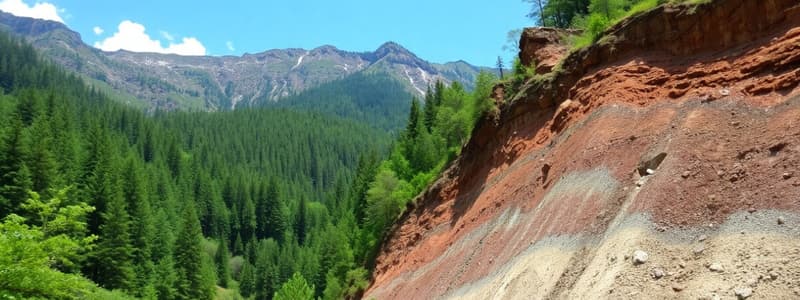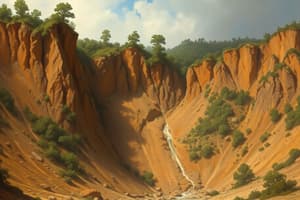Podcast
Questions and Answers
Which geological factors are considered significant in predicting rainfall-induced landslides?
Which geological factors are considered significant in predicting rainfall-induced landslides?
- Soil type and vegetation cover
- Slope and soil type (correct)
- Elevation and temperature
- Slope and seismic activity
What role does rainfall play in the occurrence of landslides?
What role does rainfall play in the occurrence of landslides?
- Weakens slope materials and rocks (correct)
- Stimulates tectonic activity
- Acts as a lubricant for earth movement
- Increases the weight of slope materials
Which of the following conditions can lead to the inevitability of landslides on steep slopes?
Which of the following conditions can lead to the inevitability of landslides on steep slopes?
- Heavy rainfall combined with vegetation growth
- Weakening of slope materials with additional load (correct)
- Regular seismic activity without additional rainfall
- Sunny weather conditions improving slope stability
What is a failure in the context of landslides?
What is a failure in the context of landslides?
Which method is mentioned as being particularly useful in evaluating areas prone to landslides?
Which method is mentioned as being particularly useful in evaluating areas prone to landslides?
Which mode of failure is characterized by the downward movement of a slope without any rotation?
Which mode of failure is characterized by the downward movement of a slope without any rotation?
What is a crucial element for effective landslide management in vulnerable communities?
What is a crucial element for effective landslide management in vulnerable communities?
During a rainfall-induced landslide, which action is advisable according to safety guidelines?
During a rainfall-induced landslide, which action is advisable according to safety guidelines?
What factor does NOT contribute to the mode of failure of a landslide?
What factor does NOT contribute to the mode of failure of a landslide?
Which of the following strategies is NOT recommended for mitigating landslide risks?
Which of the following strategies is NOT recommended for mitigating landslide risks?
What should be checked for after a landslide event?
What should be checked for after a landslide event?
What is the primary cause of the majority of sinkholes?
What is the primary cause of the majority of sinkholes?
How does suffusion lead to the formation of sinkholes?
How does suffusion lead to the formation of sinkholes?
Which factor does NOT contribute to the exposure of the mantle that can lead to sinkholes?
Which factor does NOT contribute to the exposure of the mantle that can lead to sinkholes?
What is the relationship between carbon dioxide and the formation of sinkholes?
What is the relationship between carbon dioxide and the formation of sinkholes?
What is the primary reason for the formation of carbonic acid in groundwater?
What is the primary reason for the formation of carbonic acid in groundwater?
What is the temperature requirement for a typhoon to form?
What is the temperature requirement for a typhoon to form?
Which theory explains the initial instability of air leading to typhoon formation?
Which theory explains the initial instability of air leading to typhoon formation?
What key action should be avoided near a sinkhole?
What key action should be avoided near a sinkhole?
What factor contributes to the development of storms after an upward lift of warm air in typhoon formation?
What factor contributes to the development of storms after an upward lift of warm air in typhoon formation?
Flashcards
Geological Hazard
Geological Hazard
A natural event caused by geological processes that can cause harm to people or property. Examples include landslides, earthquakes, and volcanic eruptions.
Rainfall-Induced Landslide
Rainfall-Induced Landslide
A landslide triggered by heavy rainfall. It occurs when the soil becomes saturated with water, making it unstable and prone to failure.
Factors Influencing Landslides
Factors Influencing Landslides
Factors that contribute to landslides include: steep slopes, weak soil, weathered rocks, and overloading of the slope.
Satellite Mapping for Landslides
Satellite Mapping for Landslides
Signup and view all the flashcards
Landslide Failure Types
Landslide Failure Types
Signup and view all the flashcards
Falling
Falling
Signup and view all the flashcards
Toppling
Toppling
Signup and view all the flashcards
Sliding
Sliding
Signup and view all the flashcards
Spreading
Spreading
Signup and view all the flashcards
Flowing
Flowing
Signup and view all the flashcards
Sinkhole
Sinkhole
Signup and view all the flashcards
Dissolution
Dissolution
Signup and view all the flashcards
Suffusion
Suffusion
Signup and view all the flashcards
Cover-collapse sinkhole
Cover-collapse sinkhole
Signup and view all the flashcards
Gradual cover-subsidence sinkhole
Gradual cover-subsidence sinkhole
Signup and view all the flashcards
What dissolves rocks in sinkholes?
What dissolves rocks in sinkholes?
Signup and view all the flashcards
Why are sinkholes connected to groundwater?
Why are sinkholes connected to groundwater?
Signup and view all the flashcards
What are trade winds?
What are trade winds?
Signup and view all the flashcards
Convective Theory of Typhoon Formation
Convective Theory of Typhoon Formation
Signup and view all the flashcards
What is the role of Earth's rotation in typhoon formation?
What is the role of Earth's rotation in typhoon formation?
Signup and view all the flashcards
Study Notes
Extreme Weather: Cold and Heat
- Heat Wave: A period of excessively hot weather, leading to potential health problems.
- Definition: Daily maximum temperature exceeds the average by 5°C (9°F) for a prolonged period.
- Negative effects: Skin cancer, heat stroke, dehydration, sunburn.
- Heat Cramps: Muscle pain and cramps due to excessive exertion in hot conditions.
- Heat Exhaustion: Occurs when excessive sweating leads to dehydration in hot, humid conditions.
- Heat Stroke: A life-threatening condition where the body's temperature control system fails, leading to a dangerously high body temperature (can result in death).
Extreme Weather: Cold
- Cold Wave: A rapid drop in temperature within a short period.
- Criteria: A sharp drop of 3-4°C or more below normal temperatures in regions where normal temperatures are above 40°C, or a drop of 7°C or more if normal temperatures are below 40°C, over 24 hours.
- Impact: Freezing of pipes and water mains, increased demand for heating, rise in fires.
Studying That Suits You
Use AI to generate personalized quizzes and flashcards to suit your learning preferences.




